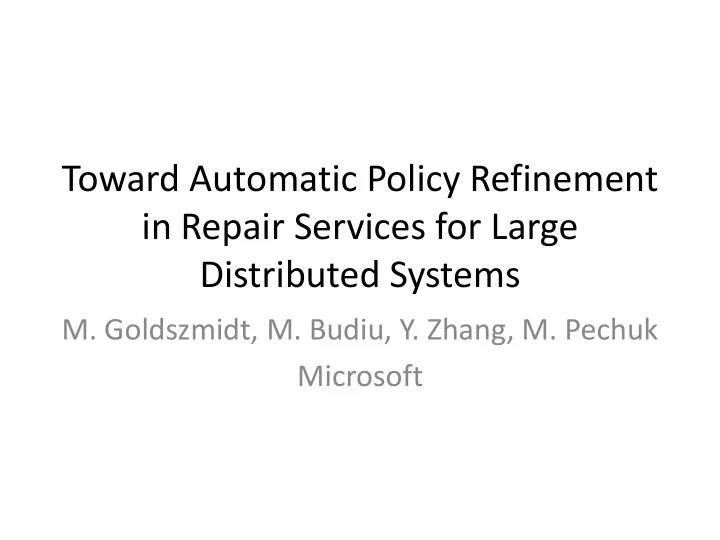

Toward Automatic Policy Refinement in Repair Services for Large Distributed Systems M. Goldszmidt, M. Budiu, Y. Zhang, M. Pechuk Microsoft
The problem we are addressing Cluster Repair actions Signals Policy manager State Monitoring system policies Policy Logs Analysis refinement Repair service 2
The repair service E.g.: ping, execute transaction, sample cpu, etc. Watchdogs: Asynchronously monitoring machines and sending signals Each machine has a state associated with it E.g.: healthy, probation, h faulty, rebooted_once, etc. A policy is a function from State to Repair Action f State transitions are R regulated by an automaton. E.g.: If probation do_nothing. A signal or a repair action will p If rebooted_once reboot. cause a state transition If dead call tier_1 operator 3
Logs Log consists of 3 months of data collected from ~ 2k machines Reason for transition h e.g. = e8382 Time of the event 2009-02-21 02:09:07 f 4
Research questions Given the data in the logs: 1. Estimate the ‘effectiveness’ of a repair action What is a “successful” repair action? 2. Suggest alternative (better) policies (without intervention) Policy Logs Analysis refinement 5
Effectiveness and success • Effectiveness time that a machine is ‘usable’ • Estimate the survival curve of the repair action P Successful repair time Successful repair = threshold on P of survival and time 6
Modeling successful repairs Automatically find a function from watchdog-signals to success Machine learning to the rescue: classification with feature selection. Logistic regression with L1 regularization 7
Models of success # selected signals: 9 CV BA: 0.872 CV confusion matrix: below above pred below 89 14 pred above 11 71 coeffs ind threshold e50202 -0.79 0.965 0.00 e8240 -0.89 0.942 0.00 e8383 0.31 0.692 1.00 e8506 -0.84 0.861 0.00 185 samples with 42 signals 8
Refining policies Automatic Human intervention NoOp RB NDI DI US T1 T2 T3 State & State Signal A policy is a function from State and Signal to Repair Action QoS, Availability costs Money, QoS, Availability costs Cost increase 9
Data processing (with Artemis) 1. Use regular expression to extract segments of data 2. Extract duration and censoring events 3. Estimate survival curves 4. Define success 5. Extract the signals before the repair action 6. Induce models of success/fail 7. Present relevant signals 10
Data visualization (with Artemis) 11
Results • Comparing different datacenters – Statistical tests on the different survivability curves – Visualization (correlation graphs) • Models for different repair actions 12
The bad sensor case E8382 How come 1 signal was predicting with 98% accuracy the failure to repair? Further investigation faulty sensor!! New models (3 months after the fix) have a mixture of many signals and E8382 appears as evidence for success… 13
Faulty repair procedure Snippet of the T1-REPAIR model coeffs ind threshold S1 -0.79 0.965 0.00 S2 -0.89 0.942 0.00 S4 -0.84 0.861 0.00 S2 is indicative of an easy fix… Why was not effective? Bug in the repair instructions…. Fixed! What about S1 and S4? 14
Final Remarks • Models directed the debugging of the repair service. – Signals that are strong indications of failed repair – Signals that are irrelevant • In two weeks the results helped improve a system that was “hand - tuned” during 6 months • Further automate the whole workflow • Induce models of correlated watchdogs • Correlate to performance data 15
Recommend
More recommend